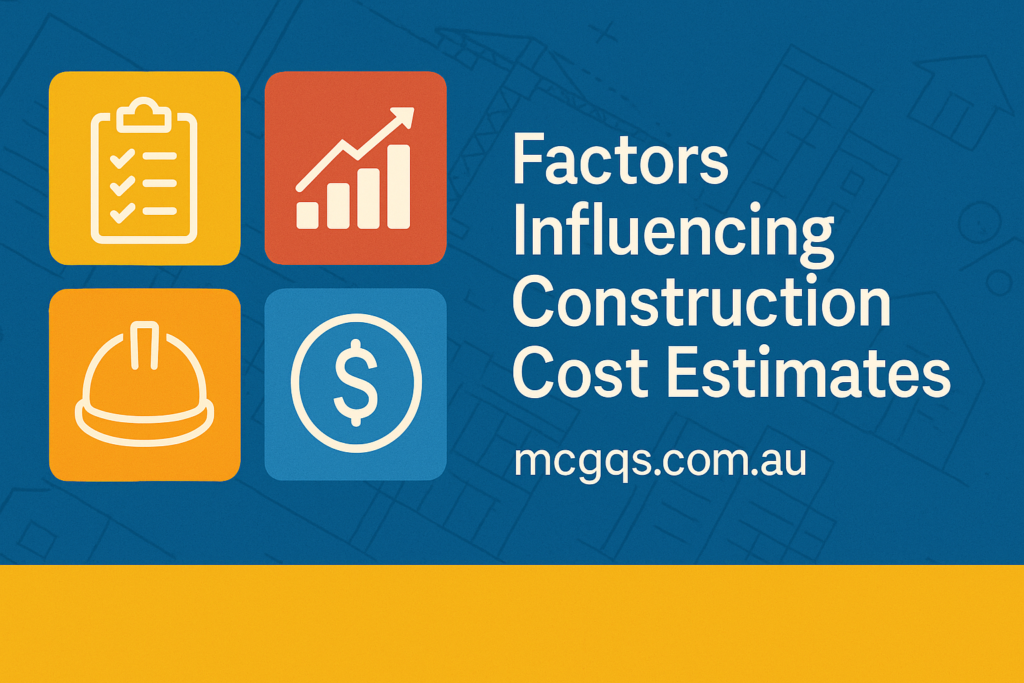Factors Influencing Construction Cost Estimates

Navigating the complexities of the construction industry requires a deep understanding of the numerous variables that play a role in determining costs. For investors, homeowners, and contractors, a comprehensive construction cost estimate is not just a figure on paper; it’s a blueprint that directs the entire project’s trajectory. With a multitude of factors influencing these estimates, it’s essential to grasp the intricacies to make informed decisions. In this post, we’ll dissect the key elements that sway construction cost estimates.
1. Project Size and Complexity
The overall scope and intricacy of a project are primary determinants of cost. Naturally, larger projects with intricate designs demand more materials, labour, and time. Conversely, smaller, straightforward designs might cost significantly less.
2. Labour Costs
Labour, often one of the most substantial expenses in construction, is influenced by:
- Wage Rates: Local labour markets and regulations play a role in determining wage rates.
- Skill Levels: Specialized tasks require skilled workers, typically commanding higher wages.
- Labour Productivity: The efficiency of the workforce can affect the duration and cost of the project.
3. Material Costs
The choice of construction materials has a profound impact on cost estimates. Factors to consider include:
- Material Type: High-end materials like marble or hardwood naturally cost more than alternatives.
- Availability: Locally sourced materials are often cheaper due to reduced transportation costs.
- Fluctuations: Prices of materials like steel or timber can vary based on global supply and demand.
4. Equipment and Machinery
The tools and machinery required for construction can significantly affect costs, depending on:
- Ownership vs. Rental: Owning equipment can sometimes be cheaper in the long run, but renting might be more cost-effective for short-term projects.
- Operational Expenses: Fuel, maintenance, and repair costs for machinery.
5. Location of the Project
The geographical location influences several cost factors:
- Accessibility: Remote locations can increase transportation costs for materials, machinery, and labour.
- Local Regulations: Certain areas might have specific building codes, demanding specialized materials or techniques.
- Site Conditions: Rocky terrains, flood zones, or areas with unstable soil can increase construction challenges and costs.
6. Project Duration
The projected timeline can influence costs in various ways:
- Extended Rentals: Longer projects mean longer equipment and machinery rental periods.
- Labour Overheads: Extended wages, accommodation for the workforce, and other associated costs.
- Inflation: For particularly long projects, inflation can increase material and labour costs over time.
7. Design Details
Architectural intricacies, custom features, and unique specifications can add to the project cost. For instance, a custom-designed stained-glass window will be pricier than a standard one.
8. Market Conditions
Economic factors play a subtle yet crucial role:
- Supply and Demand: High demand with limited labour or material supply can push prices up.
- Economic Health: During economic downturns, labour and materials might be cheaper, but financing might be more challenging to secure.
9. Regulatory and Permit Costs
Every construction project is bound by local regulations and requires specific permits. These permissions, licenses, and adherence to standards have associated fees and can affect the overall cost.
10. Contingencies
Accurate estimates always factor in unforeseen challenges. This contingency buffer, typically 5%-15% of the total cost, accounts for unexpected expenses that might arise during the project.
11. Contractor’s Markup
Finally, contractors need to make a profit, and this is added as a markup on the total estimated cost. The percentage can vary based on the contractor’s reputation, expertise, and market conditions.
Conclusion:
Crafting an accurate construction cost estimate is akin to assembling a jigsaw puzzle, where each piece, no matter how small, plays a pivotal role. Whether you’re a contractor keen on delivering transparent estimates or a homeowner seeking value for money, understanding these influencing factors offers clarity and direction.
In the ever-evolving realm of construction, costs will invariably be influenced by a myriad of elements. However, with awareness, research, and meticulous planning, estimates can be honed to reflect realistic budgets, setting the stage for successful projects that stand the test of time.
